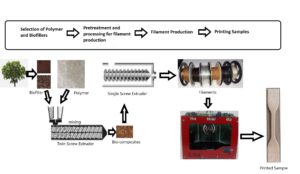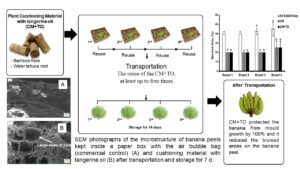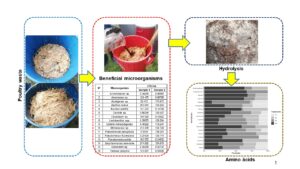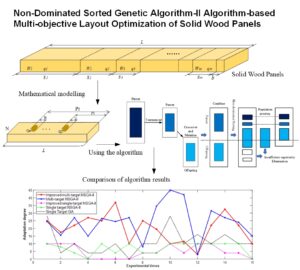Volume 17 Issue 1
Latest articles
- Editorialpp 1-2Lavoine, N. (2022). "Fostering entrepreneurial thinking in biomaterials education," BioResources 17(1), 1-2.AbstractArticlePDF
The concept of entrepreneurial thinking is gaining attention in higher education. Originally attributed to entrepreneurs, this concept embraces a set of attitudes, skills, and behaviors that can also help students, engineers, and researchers to succeed academically, professionally, and personally. This editorial discusses the benefits of developing and adopting an entrepreneurial thinking in biomaterials science and engineering. Our society is constantly evolving, and the next generations of engineers and researchers will have to adapt fast to the needs and propose innovative solutions to the demands. A strong entrepreneurial mindset may thus be key for boosting our efforts towards innovation and sustainability.
- Editorialpp 3-6Hubbe, M. A. (2022). "What to do with toxic, contaminated cellulose-based adsorbents," BioResources 17(1), 3-6.AbstractArticlePDF
This editorial considers the end fates of toxic materials, such as heavy metals, dyes, and synthetic organic compounds, which can be recovered from polluted water by using bio-based adsorbents. The point of the editorial is that insufficient research attention has been paid to the final fate of such contaminants. By contrast, much is known regarding factors affecting the adsorption capacities and rates of adsorption onto cellulose-based materials. Highly contaminated solutions are produced during the regeneration of biosorbent materials. Eutectic freeze crystallization potentially could be used to isolate relative pure compounds of heavy metals from such solutions. Alternatively, biochar can be prepared from cellulosic material in such a way as to achieve strong attachment to certain pollutants. Such biochar, after its use as an adsorbent, could be placed in the ground, where it can be expected to remain stable as sequestered carbon. A high ion exchange capacity of such biochar has potential to reduce the rates of leaching, which could otherwise lead to contamination of groundwater near to landfill sites. As shown by these examples, some promising answers to the final fate of contaminants may conform to a “circular economy” model, whereas other promising answers may conform to a “cradle-to-grave” viewpoint.
- Researchpp 7-20Majka, J., Sydor, M., Pędzik, M., Antov, P., Krišťák, Ľ., Kminiak, R., Kučerka, M., and Rogoziński, T. (2022). "Quantifying the finest particles in dust fractions created during the sanding of untreated and thermally modified beech wood," BioResources 17(1), 7-20.AbstractArticlePDF
This article deals with the fractionation of wood dust by sieve after sanding. Dust from untreated beechwood was compared to dust from thermally modified beechwood (at 200 °C for 3 h). The authors hypothesized that the thermal modification changes the particle size distributions of the dust sieve fractions and that all the dust sieve fractions contain the finest particles, which are suspendable in the air and are potentially respirable. To obtain dust for testing, both wood materials were sanded with P120 paper at a belt speed of 14.5 m/s and a pressure of 0.65 N/cm2. A set of sieves with aperture sizes of 25, 80, and 250 µm were used to separate the dust into sieve fractions with grain sizes less than 25 µm, 25 to 80 µm, 80 to 250 µm, and greater than 250 µm. The content of the finest particles in the fractions was measured via a laser particle sizer. Both dusts had similar particle size distributions. In addition, each investigated fraction of both dusts contained the finest particles, i.e., less than 10 µm. It follows that the laser analysis method may be necessary to correctly assess the occupational risk at a sanding.
- Researchpp 21-36Tokdemir, V., and Altun, S. (2022). "A case study of wood thermoplastic composite filament for 3D printing," BioResources 17(1), 21-36.AbstractArticlePDF

The 3D printing technology is a method of converting proposed complex geometric shapes into solid models. One of these methods is the FDM (fused deposition modeling) printing technology as a considerably affordable and the most commonly used method in the world. The purpose of this study is to obtain FDM 3D printer filaments that are as natural as possible, resembling wood and evoking the sensation of wood upon touching through deployment of bio-based plastics and additives. Polylactic acid (PLA) and bio thermoplastic polyurethane (TPU) were used as matrices, and lignin and Arboform, a lignin-based biomaterial, were used as additives. The characteristics of composites achieved through addition of 10% lignin and Arboform to matrices were identified by differential scanning calorimetry (DSC) thermogravimetric analysis (TGA), scanning electron microscopy (SEM), and the tensile test. The effects of some printing parameters on the mechanical characteristics were also determined. Lignin induced a decrease in mechanical characteristics for both PLA and TPU. Arboform, on the other hand, demonstrated good bonding with TPU and increased tensile strength. Production of flexible and sufficiently durable parts by means of 10% Arboform-containing TPU filaments was demonstrated.
- Researchpp 37-51Saengwong-ngam, R., Matan, N., and Matan, N. (2022). "Effects of a plant-cushioning material containing tangerine oil on bruising and mould growth of banana (Kluai Hom Thong) and its potential reuse," BioResources 17(1), 37-51.AbstractArticlePDF

The objectives of this study were to investigate the effects of a plant-cushioning material containing tangerine oil in conserving the quality of a Kluai Hom Thong banana during transportation and storage. In addition, the reuse of the plant-cushioning material with and without tangerine oil for two, three, or four transportation and storage cycles was investigated. The results demonstrated that the plant-cushioning material with tangerine oil protected the Kluai Hom Thong banana from mould growth by 100% and it reduced the bruised areas on the banana peel by 80%. The tangerine oil vapour released from the plant-cushioning material might also affect the ripening of the banana, since the colour changed from green to yellow more quickly in the fruit that had been treated with tangerine oil compared to the control fruit. In addition, this intelligent cushioning material containing tangerine oil has great potential in reducing bruised areas, inhibiting mould and extending the quality of the banana during transportation and storage (14 days) for at least one time compared to the control (5 to 7 days). The reuse of the plant-cushioning material, at least up to four times with and without tangerine oil for the protection of the banana, showed great potential.
- Researchpp 52-63Wang, X., Le, X., Peng, W., Ye, P., An, J., Zhang, G., Wang, P., and Xie, Y. (2022). "Effect of pH on the formation of benzyl ester bonds between glucuronic acid and dehydrogenation polymer," BioResources 17(1), 52-63.AbstractArticlePDF
The effect of pH on the addition reaction of glucuronic acid to quinone methides generated in the synthesis of dehydrogenation polymer (DHP or artificial lignin) was investigated. The DHP-glucuronic acid complexes were formed during DHP polymerization catalyzed by a mixture of laccase, β-glucosidase, and O2 within the pH range 7 to 4 in the presence of coniferin as a precursor. The structure of the product and the content of benzyl ester bonds were characterized by Fourier transform infrared spectroscopy, solid-state cross-polarization magic angle spinning carbon-13 nuclear magnetic resonance spectroscopy, ion chromatography, high performance liquid chromatography, and elemental analysis. The results showed that the pH of the reaction system had an important role in the formation of the benzyl ester bonds. Acidic conditions favored the reaction of quinone methide intermediates with carboxyl groups of glucuronic acid in the biosynthesis of DHP. However, weakly acidic conditions (pH 6) enhanced the reaction of quinone methide intermediates with glucose. In neutral conditions, the DHP-protein complex can be efficiently synthesized by the addition reaction of quinone methide intermediates with amino acids in protein.
- Researchpp 64-74Alvarez-Vera, M., Vázquez, J., Fernández, D., and Reinoso, R. (2022). "Poultry feathers and offal treatment by using beneficial microorganisms," BioResources 17(1), 64-74.AbstractArticlePDF

Poultry waste can be hydrolyzed using microorganisms to obtain useful amino acids for agriculture processes. This research treated poultry waste by applying beneficial microbial consortia. Microorganisms were obtained from Brassica oleracea (commonly known as cabbage) and Jungia rugosa (widely known as matico de puna) plants. Each sample was sent to the laboratory for gender, species, and concentration identification. Poultry waste (feathers, offal, blood) and a liquid solution made up of water, molasses, and microorganisms were placed inside plastic tanks. Four treatments were established (T1, T2, T3, and T4). T1 and T3 were composed of 80% water, 10% molasses, and 10% microorganisms; T2 and T4 were composed of 70% water, 20% molasses, and 10% microorganisms. The contents in each tank were periodically stirred for one month. Sixteen microorganisms were identified in each sample. In each treatment, nine essential and nine non-essential amino acids were found in different concentration levels. It is assumed that indigenous microbial consortia benefit the hydrolysis of poultry waste. Furthermore, the type and content of amino acids are related to the microbial activity of each consortium.
- Researchpp 75-93Chen, F., Liu, Y., Ni, X., and Xia, X. (2022). "Eulerian-Lagrangian simulation of wood flour and wind distribution during the impulse-cyclone airflow drying process," BioResources 17(1), 75-93.AbstractArticlePDF
To improve the particle transport computational fluid dynamics models of impulse-cyclone airflow drying systems, a Eulerian-Lagrangian discrete particle model (commercial code ANSYS Fluent 2019 R1) was extended to describe the temperature field, airflow velocity field, and particle distribution in the impulse and cyclone dryers. The results showed that the velocity of the airflow considerably changed after wood flour was added into the system, with an approximate velocity difference between the particles and airflow of 2 m/s. An increased feed rate led to a backflow area at the bottom of the cyclone dryer, which caused reflux and a long residence time of the wood flour in and near the cyclone dryer. By comparing the calculated temperature, velocity, and time curves with the measured temperature and velocity sensor values, the error between the simulated value and the experimental value was only approximately 15%. The current work verifies that the Eulerian-Lagrangian discrete particle model of the impulse-cyclone airflow drying process established via the computational fluid dynamics simulation method was effective. The conclusion provides a reliable theoretical basis for the technological design of impulse-cyclone airflow drying systems, thus providing a way to optimize the structure of impulse-cyclone airflow drying systems in the future.
- Researchpp 94-108Wang, B., Yang, C., and Ding, Y. (2022). "Non-dominated sorted genetic algorithm-II algorithm-based multi-objective layout optimization of solid wood panels," BioResources 17(1), 94-108.AbstractArticlePDF

Common solid wood panel defects affect the appearance of timber products and reduce their value for use. It is necessary to remove defects from solid wood panels to achieve a panel layout. A whole wooden beam column is cut into solid wood panels of different sizes, according to the requirements. Aiming to overcome problems of weak convergence ability, single-objective optimization, and the poor optimization effect of solid wood panel layout optimization based on a traditional genetic algorithm, an improved multi-objective solid wood panel layout optimization based on NSGA-II (Non-dominated sorted genetic algorithm-II) algorithm was proposed. Reverse learning was used to generate a reverse population to increase the search capability of the algorithm and to solve the problem of insufficient population diversity in the genetic algorithms. A combination of directional variation and uniform variation was used to improve the optimization effect and solve the problem of small individual differences in the evolution of the algorithm. The improved multi-objective optimization algorithm showed better optimization and stability than the NSGA-II algorithm. The number of convergence iterations was reduced and simultaneous optimization of multiple objectives can be realized.
- Researchpp 109-131Maidin, N. A., Mohd Sapuan, S., Mohammad Taha, M., and Mohamed Yusoff, M. Z. (2022). "Material selection of natural fibre using a grey relational analysis (GRA) approach," BioResources 17(1), 109-131.AbstractArticlePDF
Numerous situations in daily life necessitate a decision. Several of them entail selecting the best option from a number of available options. In many such cases, no single solution is optimal for all of the performance characteristics. This study proposes using grey relational analysis (GRA), a multiple criteria decision making (MCDM) method, to solve this problem. Material selection is vital in designing and developing products, especially for composites materials requiring special attention. The substitution of conventional materials with natural fibres as base material is commonly practised due to high material consumption in mass-producing plastic components that could harm the environment. Therefore, in this work, natural fibres were chosen as composite reinforcement in the design of cyclist helmets. This approach was used to evaluate the right natural fibre and is able to fulfill the needs of consumers and the environment. From the results, the GRA method was utilised and revealed that pineapple was the best top ranking natural fibre with a grade of 0.5687, followed closely by bamboo with a grade of 0.5678, and abaca with a grade of 0.4966. Error analysis was performed to increase the confidence level of the results obtained.
